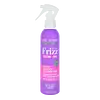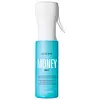What's inside
What's inside
 Benefits
Benefits

 Concerns
Concerns

 Ingredients Side-by-side
Ingredients Side-by-side

Water
Skin ConditioningCetyl Alcohol
EmollientBehentrimonium Chloride
PreservativePPG-3 Benzyl Ether Myristate
EmollientPhenoxyethanol
PreservativeCaprylic/Capric Triglyceride
MaskingCocos Nucifera Oil
MaskingPropanediol
SolventStearyl Alcohol
EmollientParfum
MaskingIsopropyl Alcohol
SolventEthylhexylglycerin
Skin ConditioningSodium Laneth-40 Maleate/Styrene Sulfonate Copolymer
Citronellol
PerfumingLinalool
PerfumingCrambe Abyssinica Seed Oil
Skin ConditioningLimonene
PerfumingBenzyl Salicylate
PerfumingButylphenyl Methylpropional
PerfumingPotassium Sorbate
PreservativeCitric Acid
BufferingWater, Cetyl Alcohol, Behentrimonium Chloride, PPG-3 Benzyl Ether Myristate, Phenoxyethanol, Caprylic/Capric Triglyceride, Cocos Nucifera Oil, Propanediol, Stearyl Alcohol, Parfum, Isopropyl Alcohol, Ethylhexylglycerin, Sodium Laneth-40 Maleate/Styrene Sulfonate Copolymer, Citronellol, Linalool, Crambe Abyssinica Seed Oil, Limonene, Benzyl Salicylate, Butylphenyl Methylpropional, Potassium Sorbate, Citric Acid
Water
Skin ConditioningButylene Glycol
HumectantBehentrimonium Chloride
PreservativeCetyl Alcohol
EmollientPolyquaternium-55
Hydrolyzed Rice Protein
Skin ConditioningAdansonia Digitata Seed Extract
Skin ConditioningAmaranthus Caudatus Seed Extract
Skin ConditioningPropanediol
SolventStearamidopropyl Dimethylamine
EmulsifyingStearyl Alcohol
EmollientDicetyldimonium Chloride
EmulsifyingHydrolyzed Vegetable Protein Pg-Propyl Silanetriol
Skin ConditioningCrambe Maritima Leaf Extract
Skin ConditioningChlorella Pyrenoidosa Extract
Skin ConditioningChondrus Crispus Extract
Skin ConditioningUndaria Pinnatifida Extract
Skin ConditioningLaminaria Saccharina Extract
Skin ProtectingParfum
MaskingCeteareth-20
CleansingCaprylyl Glycol
EmollientPhenoxyethanol
PreservativeCitric Acid
BufferingPotassium Benzoate
PreservativeDimethicone
EmollientPotassium Sorbate
PreservativePropylene Glycol
HumectantSodium Benzoate
MaskingDisodium EDTA
Isopropyl Alcohol
SolventBenzyl Salicylate
PerfumingAlpha-Isomethyl Ionone
PerfumingWater, Butylene Glycol, Behentrimonium Chloride, Cetyl Alcohol, Polyquaternium-55, Hydrolyzed Rice Protein, Adansonia Digitata Seed Extract, Amaranthus Caudatus Seed Extract, Propanediol, Stearamidopropyl Dimethylamine, Stearyl Alcohol, Dicetyldimonium Chloride, Hydrolyzed Vegetable Protein Pg-Propyl Silanetriol, Crambe Maritima Leaf Extract, Chlorella Pyrenoidosa Extract, Chondrus Crispus Extract, Undaria Pinnatifida Extract, Laminaria Saccharina Extract, Parfum, Ceteareth-20, Caprylyl Glycol, Phenoxyethanol, Citric Acid, Potassium Benzoate, Dimethicone, Potassium Sorbate, Propylene Glycol, Sodium Benzoate, Disodium EDTA, Isopropyl Alcohol, Benzyl Salicylate, Alpha-Isomethyl Ionone
Ingredients Explained
These ingredients are found in both products.
Ingredients higher up in an ingredient list are typically present in a larger amount.
This ingredient is a preservative and often used for it's anti-static properties. You'll most likely see this ingredient in hair conditioners.
It does not cause irritation or sensitization in leave-on products at 1-5%.
Benzyl Salicylate is a solvent and fragrance additive. It is an ester of benzyl alcohol and salicylic acid. This ingredient can be naturally found in some plants and plant extracts.
In fragrances, Benzyl Salicylate may be a solvent or a fragrance component. In synthetic musk scents, it is used as a solvent. For floral fragrances such as lilac and jasmine, it is used as a fragrance component. The natural scent of Benzyl Salicylate is described as "lightly-sweet, slightly balsamic".
While Benzyl Salicylate has been associated with contact dermatitis and allergies, emerging studies show it may not be caused by this ingredient alone.
However, this ingredient is often used with fragrances and other components that may cause allergies. It is still listed as a known allergen in the EU. We recommend speaking with a professional if you have concerns.
Another study from 2021 shows Benzyl Salicylate may have anti-inflammatory properties.
Learn more about Benzyl SalicylateCetyl Alcohol is a fatty alcohol. Fatty Alcohols are most often used as an emollient or to thicken a product.
Its main roles are:
Though it has "alcohol" in the name, it is not related to denatured alcohol or ethyl alcohol.
The FDA allows products labeled "alcohol-free" to have fatty alcohols.
Learn more about Cetyl AlcoholCitric Acid is an alpha hydroxy acid (AHA) naturally found in citrus fruits like oranges, lemons, and limes.
Like other AHAs, citric acid can exfoliate skin by breaking down the bonds that hold dead skin cells together. This helps reveal smoother and brighter skin underneath.
However, this exfoliating effect only happens at high concentrations (20%) which can be hard to find in cosmetic products.
Due to this, citric acid is usually included in small amounts as a pH adjuster. This helps keep products slightly more acidic and compatible with skin's natural pH.
In skincare formulas, citric acid can:
While it can provide some skin benefits, research shows lactic acid and glycolic acid are generally more effective and less irritating exfoliants.
Most citric acid used in skincare today is made by fermenting sugars (usually from molasses). This synthetic version is identical to the natural citrus form but easier to stabilize and use in formulations.
Read more about some other popular AHA's here:
Learn more about Citric AcidIsopropyl Alcohol is more commonly known as rubbing alcohol. It is most commonly used as a solvent, meaning it helps other ingredients dissolve.
This ingredient is an astringent alcohol. Astringent alcohols may also irritate skin as they high amounts may strip away your skin's natural oils.
Other types of astringent alcohols include:
According to the National Rosacea Society based in the US, you should be mindful of products with these alcohols in the top half of ingredients.
Any type of sanitizing product will have high amounts of alcohol to help kill bacteria and viruses.
Learn more about Isopropyl AlcoholParfum is a catch-all term for an ingredient or more that is used to give a scent to products.
Also called "fragrance", this ingredient can be a blend of hundreds of chemicals or plant oils. This means every product with "fragrance" or "parfum" in the ingredients list is a different mixture.
For instance, Habanolide is a proprietary trade name for a specific aroma chemical. When used as a fragrance ingredient in cosmetics, most aroma chemicals fall under the broad labeling category of “FRAGRANCE” or “PARFUM” according to EU and US regulations.
The term 'parfum' or 'fragrance' is not regulated in many countries. In many cases, it is up to the brand to define this term.
For instance, many brands choose to label themselves as "fragrance-free" because they are not using synthetic fragrances. However, their products may still contain ingredients such as essential oils that are considered a fragrance by INCI standards.
One example is Calendula flower extract. Calendula is an essential oil that still imparts a scent or 'fragrance'.
Depending on the blend, the ingredients in the mixture can cause allergies and sensitivities on the skin. Some ingredients that are known EU allergens include linalool and citronellol.
Parfum can also be used to mask or cover an unpleasant scent.
The bottom line is: not all fragrances/parfum/ingredients are created equally. If you are worried about fragrances, we recommend taking a closer look at an ingredient. And of course, we always recommend speaking with a professional.
Learn more about ParfumPhenoxyethanol is a preservative that has germicide, antimicrobial, and aromatic properties. Studies show that phenoxyethanol can prevent microbial growth. By itself, it has a scent that is similar to that of a rose.
It's often used in formulations along with Caprylyl Glycol to preserve the shelf life of products.
Potassium Sorbate is a preservative used to prevent yeast and mold in products. It is commonly found in both cosmetic and food products.
This ingredient comes from potassium salt derived from sorbic acid. Sorbic acid is a natural antibiotic and effective against fungus.
Both potassium sorbate and sorbic acid can be found in baked goods, cheeses, dried meats, dried fruit, ice cream, pickles, wine, yogurt, and more.
You'll often find this ingredient used with other preservatives.
Learn more about Potassium SorbatePropanediol is an all-star ingredient. It softens, hydrates, and smooths the skin.
It’s often used to:
Propanediol is not likely to cause sensitivity and considered safe to use. It is derived from corn or petroleum with a clear color and no scent.
Learn more about PropanediolStearyl Alcohol is a type of fatty alcohol from stearic acid. It is a white, waxy compound used to emulsify ingredients.
Fatty Alcohols are most often used as an emollient or to thicken a product. Emollients help soothe and hydrate the skin by trapping moisture.
They are usually derived from natural fats and oils and therefore do not have the same drying or irritating effect as solvent alcohols. FDA allows products labeled "alcohol-free" to have fatty alcohols.
Learn more about Stearyl AlcoholWater. It's the most common cosmetic ingredient of all. You'll usually see it at the top of ingredient lists, meaning that it makes up the largest part of the product.
So why is it so popular? Water most often acts as a solvent - this means that it helps dissolve other ingredients into the formulation.
You'll also recognize water as that liquid we all need to stay alive. If you see this, drink a glass of water. Stay hydrated!
Learn more about Water